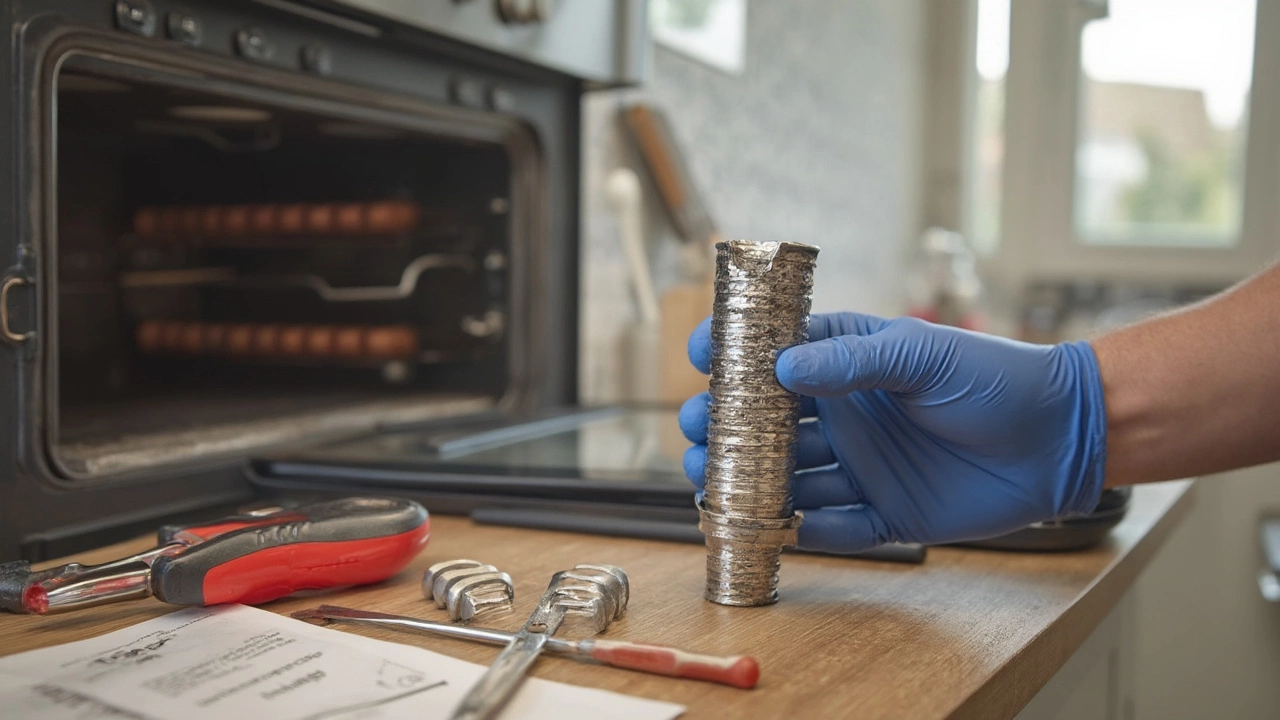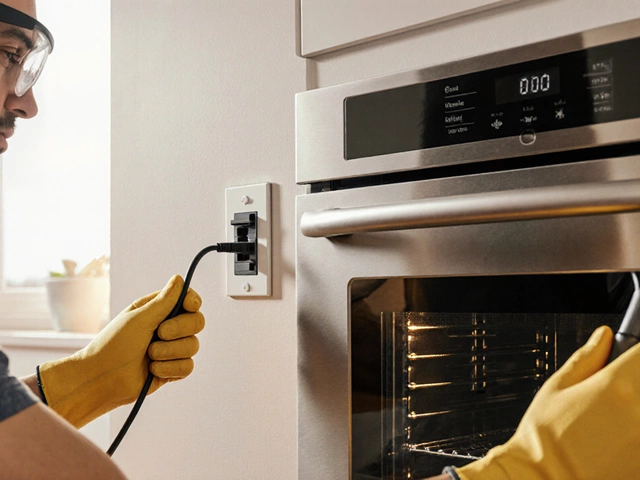If your oven isn't getting hot—or you're stuck with weird cold spots that turn brownies into a guessing game—it could be the heating element. This little part is the backbone of any electric oven, doing the heavy lifting to get things cooking. Without it, you're basically stuck with a fancy kitchen storage cabinet.
So, how do you know when it's time to swap it out and, most importantly, what is the damage to your wallet? Let’s clear up the confusion before you shell out cash or try a DIY fix. Pricing can vary more than you’d think, and sometimes it’s not just about the cost of the part itself, but the steps (and possible headaches) involved in making your oven work like new again.
- What Does a Heating Element Do in Your Oven?
- Signs You Need a Replacement
- How Much Does Replacement Cost?
- DIY or Hire a Pro? What to Expect
What Does a Heating Element Do in Your Oven?
The heating element is basically the muscle behind your electric oven. It's a thick, metal coil (sometimes shaped like a squiggly loop) that turns electricity into heat, making sure your food bakes, roasts, or broils at the temperature you set. There are usually two of these in an electric oven—one at the bottom (bake element) and one at the top (broil element).
When you turn the oven on, electric current flows through these coils. The resistance in the coil heats it up, and that’s what creates the cooking heat inside your oven. If the element doesn’t work, the oven might not heat up at all or won’t reach the right temperature. This is why a busted element pretty much means no lasagna for dinner unless you fix it.
Most modern ovens use elements that are designed to get really hot—up to about 500°F (260°C) when you crank them up. They need to handle this heat several times a week for years. It's no surprise that, after a while, the oven heating element might burn out, get cracks, or develop hot spots that cause uneven cooking.
- Bottom element (bake): Handles most of the routine heating
- Top element (broil): Used for extra heat when you want a crispy top or fast searing
If your oven’s taking way too long to preheat or you notice glowing only in certain spots along the coil, odds are the heating element could be failing.
| Element Type | Normal Heating Range |
|---|---|
| Bake (Bottom) | 170°F – 500°F |
| Broil (Top) | 400°F – 550°F |
Signs You Need a Replacement
Wondering if your oven’s on the fritz because of a bad heating element? There are a few clues that scream “swap me out” long before your dinner fails. Let’s break down the obvious—and not so obvious—signs.
- Uneven Cooking: Picture biting into a lasagna that’s hot on one side and cold on the other. That’s a textbook symptom that the oven heating element is failing and not spreading heat right.
- No Heat at All: If you turn on your oven and it just hums along cold, the element may have reached the end of its life. A working oven should start getting warm within minutes.
- Visible Damage: Open up your oven—if you see cracks, blisters, or the element’s pieces have broken off, it’s time for a new one.
- Sparks or Smoke: Don’t ignore sparks or a smoky smell. This isn’t just an inconvenience—it’s a fire risk and means you need to turn off your oven fast and unplug it.
The heating element should start glowing bright orange when it’s working right. If it stays dull, dark, or has spots that don't light up, that's your sign.
| Symptom | Most Likely Cause |
|---|---|
| Food cooks unevenly | Heating element isn’t distributing heat |
| Oven doesn’t heat at all | Heating element burned out |
| Sparks or burning smell | Worn or broken element |
If you’re still on the fence, a simple DIY check is to turn on the oven, set it to max, and peek in after a few minutes. No orange, no heat—it’s probably time for that heating element replacement.

How Much Does Replacement Cost?
So, what's the real cost to replace an oven heating element? Most folks spend somewhere between $30 and $60 for the part itself. The exact price depends on your oven's make, model, and whether you’re buying a genuine part or a universal brand. For some high-end or fancy European ovens, the element alone can run up to $100, but that's rare for standard home ovens.
If you decide you want a pro to handle it, that's where your cost bumps up. The average labor charge in the U.S. for installing a heating element replacement sits around $100 to $150. Some repair shops charge a flat rate, others by the hour (usually $75-$125 per hour). When you add everything up, most people pay between $130 and $200 total for both part and labor.
Here's a quick breakdown to give you a better picture:
| Cost Item | Price Range (USD) |
|---|---|
| Heating Element (Basic) | $30 - $60 |
| Heating Element (Premium/Brand) | $60 - $100 |
| Professional Labor | $100 - $150 |
| Total (DIY) | $30 - $100 |
| Total (Pro Install) | $130 - $200 |
Some tips to cut the costs: Always double-check your oven’s model number before ordering a replacement part. Sometimes, generic or off-brand elements work just as well and cost much less. But be careful—using the wrong part can leave you with a dinner disaster. And if your oven is still under warranty, repairs might cost you nothing—manufacturer warranties often cover heating element issues within the first year.
If you’re game to swap the element yourself, you’ll save on labor. There are plenty of step-by-step guides and videos online. Just make sure to unplug the oven first—getting zapped is not part of the recipe!
DIY or Hire a Pro? What to Expect
If your electric oven's acting up, you’re probably wondering if you can tackle the heating element replacement yourself or if it’s worth calling in a pro. Both routes have their pros and cons, and the right choice depends on your comfort level, tools at home, and how much you want to spend.
First up—DIY isn’t as wild as it sounds. Most modern ovens make it pretty easy. The job usually involves unscrewing a few bolts, disconnecting old wires, swapping in the new element, and putting it all back together. No need for fancy gear—just a screwdriver, maybe a socket set, and a healthy dose of caution. Always unplug the oven or cut off the power at the breaker before touching anything.
Here’s a typical step-by-step:
- Unplug your oven or switch off the breaker.
- Remove the screws holding the old element in place.
- Disconnect the wires (snap a pic with your phone so you remember where they go).
- Connect the new element to the wires.
- Secure the new element with screws. Push it gently into place.
- Plug the oven back in, flip the breaker, and give it a test run.
The oven repair part itself might take 20–40 minutes if you’re handy. You can get replacement elements for most brands online or at an appliance store. Typical costs for the part? Usually $20–$80, depending on your oven model.
Now, if your oven is older, the wiring looks sketchy, or you just don’t feel comfortable with electrical work, don’t sweat it. Hiring a pro is super common—no shame in being safe. Professional labor generally runs $100–$200 plus the cost of the element itself. Some repair companies charge a service fee just to show up, so always ask for a breakdown of charges up front. A certified tech will usually get the job done in under an hour and will test everything to make sure it’s running right before they leave.
| Option | Typical Total Cost | Time Needed |
|---|---|---|
| DIY | $20–$80 (just parts) | 20–40 minutes |
| Professional | $120–$280 (parts + labor) | ~1 hour |
When in doubt, remember: ovens run on high voltage. If anything looks burnt, corroded, or confusing, don’t push your luck—let a pro handle it. You’ll save money with DIY if all goes well, but it’s not worth risking a major zap or a ruined stove if you’re unsure.







